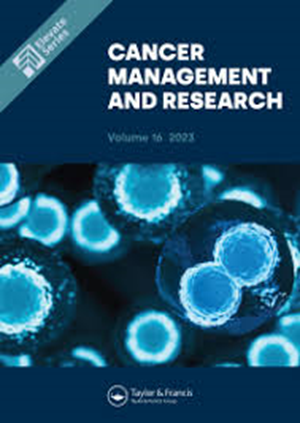Green Dentistry in Oral Cancer Treatment Using Biosynthesis Superparamagnetic Iron Oxide Nanoparticles: A Systematic Review
IF 2.5
4区 医学
Q3 ONCOLOGY
引用次数: 0
Abstract
Abstract: Oral cancer is a worldwide health issue with high incidence and mortality, demands an effective treatment to improve patient prognosis. Superparamagnetic iron oxide nanoparticles (SPIONs) emerged as a candidate for oral cancer treatment due to their unique attributes, enabling a synergistic combination with its drug-delivery capabilities and hyperthermia when exposed to magnetic fields. SPIONs can be synthesized using biopolymers from agricultural waste like lignin from paddy, which produce biogenic nano iron oxide with superparamagnetic and antioxidant effects. In addition, lignin also acts as a stabilizing agent in creating SPIONs. This study aimed to explore how agricultural waste could be used to prepare SPIONs using the green synthesis method and to evaluate its potential for oral cancer specifically focusing on its effectiveness, side effects, biocompatibility, and toxicity. A systematic review was conducted following the Preferred Reporting Items for Systematic Reviews and Meta-Analyses protocol. PubMed, EBSCO, and Scopus databases were exploited in the selection of articles published within the last decade. This study quality assessment uses OHAT for critical appraisal tools. Only 10 studies met the inclusion criteria. The findings suggest that the use of agricultural waste in the preparation of SPIONs not only holds potency for oral cancer treatment through drug delivery and hyperthermia but also aligns with the concept of green dentistry. SPIONs as a treatment modality for oral cancer have demonstrated notable effectiveness and versatility. This study provides robust evidence supporting green dentistry by using agricultural waste in the preparation and formulation of SPIONs for managing oral cancer. Its multifunctional nature and ability to enhance treatment efficacy while minimizing adverse effects on healthy tissues highlights the potency of SPION-based oral cancer treatments.Keywords: SPIONs, oral cancer, treatment, biosynthesis, green dentistry
利用生物合成超顺磁性氧化铁纳米粒子治疗口腔癌的绿色牙科:系统综述
摘要:口腔癌是一个世界性的健康问题,发病率和死亡率都很高,需要一种有效的治疗方法来改善患者的预后。超顺磁性氧化铁纳米粒子(SPIONs)因其独特的属性而成为口腔癌治疗的候选材料,当暴露在磁场中时,SPIONs能与药物输送功能和热疗功能协同作用。SPIONs 可利用农业废弃物(如稻谷中的木质素)中的生物聚合物合成,从而产生具有超顺磁性和抗氧化作用的生物纳米氧化铁。此外,木质素还可作为稳定剂生成 SPIONs。本研究旨在探讨如何利用农业废弃物采用绿色合成法制备 SPIONs,并评估其治疗口腔癌的潜力,特别关注其有效性、副作用、生物相容性和毒性。我们按照《系统综述和元分析首选报告项目》(Preferred Reporting Items for Systematic Reviews and Meta-Analyses)协议进行了系统综述。在选择过去十年内发表的文章时,使用了 PubMed、EBSCO 和 Scopus 数据库。本研究质量评估使用 OHAT 作为关键评估工具。只有 10 项研究符合纳入标准。研究结果表明,利用农业废弃物制备 SPIONs 不仅可以通过药物输送和热疗治疗口腔癌,而且符合绿色牙科的概念。SPIONs作为一种治疗口腔癌的方法,已显示出显著的有效性和多功能性。本研究通过利用农业废弃物制备和配制 SPIONs 来治疗口腔癌,为绿色牙科提供了有力的证据支持。SPIONs的多功能性以及在提高治疗效果的同时减少对健康组织的不良影响的能力,凸显了基于SPIONs的口腔癌治疗方法的潜力:SPIONs、口腔癌、治疗、生物合成、绿色牙科
本文章由计算机程序翻译,如有差异,请以英文原文为准。
求助全文
约1分钟内获得全文
求助全文
来源期刊

Cancer Management and Research
Medicine-Oncology
CiteScore
7.40
自引率
0.00%
发文量
448
审稿时长
16 weeks
期刊介绍:
Cancer Management and Research is an international, peer reviewed, open access journal focusing on cancer research and the optimal use of preventative and integrated treatment interventions to achieve improved outcomes, enhanced survival, and quality of life for cancer patients. Specific topics covered in the journal include:
◦Epidemiology, detection and screening
◦Cellular research and biomarkers
◦Identification of biotargets and agents with novel mechanisms of action
◦Optimal clinical use of existing anticancer agents, including combination therapies
◦Radiation and surgery
◦Palliative care
◦Patient adherence, quality of life, satisfaction
The journal welcomes submitted papers covering original research, basic science, clinical & epidemiological studies, reviews & evaluations, guidelines, expert opinion and commentary, and case series that shed novel insights on a disease or disease subtype.
 求助内容:
求助内容: 应助结果提醒方式:
应助结果提醒方式:


